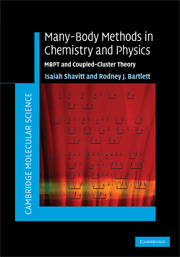Book contents
- Frontmatter
- Contents
- Preface
- 1 Introduction
- 2 Formal perturbation theory
- 3 Second quantization
- 4 Diagrammatic notation
- 5 Diagrammatic expansions for perturbation theory
- 6 Proof of the linked-diagram theorem
- 7 Computational aspects of MBPT
- 8 Open-shell and quasidegenerate perturbation theory
- 9 Foundations of coupled-cluster theory
- 10 Systematic derivation of the coupled-cluster equations
- 11 Calculation of properties in coupled-cluster theory
- 12 Additional aspects of coupled-cluster theory
- 13 The equation-of-motion coupled-cluster method for excited, ionized and electron-attached states
- 14 Multireference coupled-cluster methods
- References
- Author index
- Subject index
2 - Formal perturbation theory
Published online by Cambridge University Press: 06 January 2010
- Frontmatter
- Contents
- Preface
- 1 Introduction
- 2 Formal perturbation theory
- 3 Second quantization
- 4 Diagrammatic notation
- 5 Diagrammatic expansions for perturbation theory
- 6 Proof of the linked-diagram theorem
- 7 Computational aspects of MBPT
- 8 Open-shell and quasidegenerate perturbation theory
- 9 Foundations of coupled-cluster theory
- 10 Systematic derivation of the coupled-cluster equations
- 11 Calculation of properties in coupled-cluster theory
- 12 Additional aspects of coupled-cluster theory
- 13 The equation-of-motion coupled-cluster method for excited, ionized and electron-attached states
- 14 Multireference coupled-cluster methods
- References
- Author index
- Subject index
Summary
Background
There are two stages in the study of perturbation theory and related techniques (although they are mixed intimately in most derivations in the literature). The first is the formal development, carried out in terms of the total Hamiltonian and total wave function (and total zero-order wave function), without attempt to express anything in terms of one- and two-body quantities (components of Ĥ, orbitals, integrals over orbitals etc.). We can make a considerable amount of progress in this way before considering the detailed form of Ĥ. The second is the many-body development, where all expressions are obtained in terms of orbitals (one-electron states) and oneand two-electron integrals. We shall try to keep these separate for a while and begin with a consideration of formal perturbation theory.
Another aspect of the study of many-body techniques is the large variety of approaches, notations and derivations that have been used. Each different approach has contributed to the lore and the language of many-body theory, and each tends to illuminate some aspects better than the other approaches. If we want to be able to read the literature in this field, we should be familiar with several alternative formulations. Therefore, we shall occasionally derive some results in more than one way and, in particular, we shall derive the basic perturbation-theory equations and their many-body representations in several complementary ways.
Classical derivation of Rayleigh–Schrödinger perturbation theory
The perturbation Ansatz
We begin with a classical textbook derivation of formal Rayleigh–Schrödinger perturbation theory (RSPT).
- Type
- Chapter
- Information
- Many-Body Methods in Chemistry and PhysicsMBPT and Coupled-Cluster Theory, pp. 18 - 53Publisher: Cambridge University PressPrint publication year: 2009



